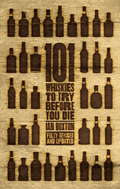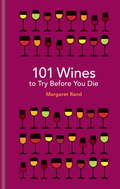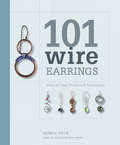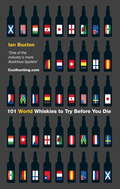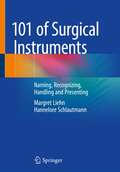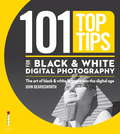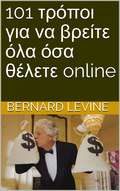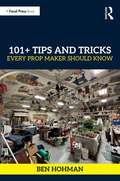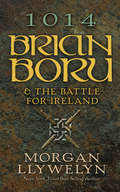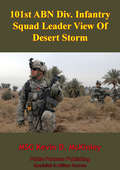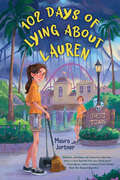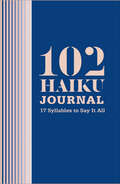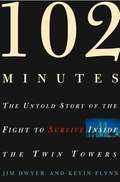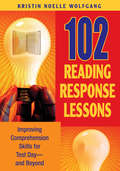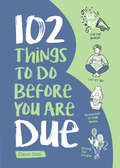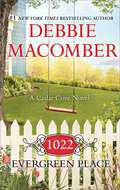- Table View
- List View
101 Whiskies to Try Before You Die (Revised & Updated)
by Ian BuxtonRevised and updated in 2013, 101 Whiskies to Try Before You Die is a whisky guide with a difference. It is not an awards list. It is not a list of the 101 'best' whiskies in the world in the opinion of a self-appointed whisky guru. It is simply a guide to the 101 whiskies that enthusiasts must seek out and try in order to complete their whisky education. Avoiding the deliberately obscure, the ridiculously limited and the absurdly expensive, whisky expert Ian Buxton recommends an eclectic selection of old favourites, stellar newcomers and mystifyingly unknown drams that simply have to be drunk. The book decodes the marketing hype and gets straight to the point; whether from India, America, Sweden, Ireland, Japan or the hills, glens and islands of Scotland, here are the 101 whiskies that you really want. Try them before you die - Slainte!
101 Whiskies to Try Before You Die (Revised and Updated): 4th Edition
by Ian BuxtonFourth edition, fully revised and updated.101 Whiskies to Try Before You Die is a whisky guide with a difference. It is not an awards list. It is not a list of the 101 'best' whiskies in the world in the opinion of a self-appointed whisky guru. It is simply a guide to the 101 whiskies that enthusiasts must seek out and try in order to complete their whisky education. Avoiding the deliberately obscure, the ridiculously limited and the absurdly expensive, whisky expert Ian Buxton recommends an eclectic selection of old favourites, stellar newcomers and mystifyingly unknown drams that simply have to be drunk.The book decodes the marketing hype and gets straight to the point; whether from Canada, India, America, Sweden, Ireland, Japan or the hills, glens and islands of Scotland, here are the 101 whiskies that you really want. Try them before you die - Slainte!
101 Whiskies to Try Before You Die (Revised and Updated): 4th Edition
by Ian BuxtonFourth edition, fully revised and updated.101 Whiskies to Try Before You Die is a whisky guide with a difference. It is not an awards list. It is not a list of the 101 'best' whiskies in the world in the opinion of a self-appointed whisky guru. It is simply a guide to the 101 whiskies that enthusiasts must seek out and try in order to complete their whisky education. Avoiding the deliberately obscure, the ridiculously limited and the absurdly expensive, whisky expert Ian Buxton recommends an eclectic selection of old favourites, stellar newcomers and mystifyingly unknown drams that simply have to be drunk.The book decodes the marketing hype and gets straight to the point; whether from Canada, India, America, Sweden, Ireland, Japan or the hills, glens and islands of Scotland, here are the 101 whiskies that you really want. Try them before you die - Slainte!
101 Wines to try before you die
by Margaret RandThe world is full of wines. So why waste your time drinking something mediocre? Award-winning author Margaret Rand has selected the 101 wines you should taste in your lifetime. Some will definitely challenge your bank balance - but are so worth it; some are classics that any serious wine lover should experience; others are secret inexpensive gems that you will be delighted to discover. Together they form a fabulous selection of must-drink wines.From the prestigious vineyards of France and California to lesser-known wine makers in Hungary and Greece, discover the best wines from across the globe. Complete with tasting notes, advice on the best vintages and dishes to pair with the wines, this is the perfect gift for both wine aficionados and wine novices alike.
101 Wines to try before you die
by Margaret RandThe world is full of wines. So why waste your time drinking something mediocre? Award-winning author Margaret Rand has selected the 101 wines you should taste in your lifetime. Some will definitely challenge your bank balance - but are so worth it; some are classics that any serious wine lover should experience; others are secret inexpensive gems that you will be delighted to discover. Together they form a fabulous selection of must-drink wines.From the prestigious vineyards of France and California to lesser-known wine makers in Hungary and Greece, discover the best wines from across the globe. Complete with tasting notes, advice on the best vintages and dishes to pair with the wines, this is the perfect gift for both wine aficionados and wine novices alike.
101 Wire Earrings: Step-by-Step Projects & Techniques
by Denise PeckWire is the hottest trend in jewelry making.101 Wire Earrings gives wireworkers of all skill levels the information and inspiration to make innovative, stylish, and contemporary earrings.Following in the footsteps of Wire Style, author Denise Peck offers an inspiring selection of 101 stunning wire earrings from top designers. The clear instructions are enhanced by step-by-step photographs and the projects are broken into beginner, intermediate, and advanced categories.Included inside:Step by step instructions on how to make head pins and French ear wiresTechniques for hammering and texturing wire Tricks to coil, spiral, harden, and straighten wire Definitions of the important elements that make up earrings, including headpins, jump rings, hoops, loops, coils, spirals, ear wires.With projects that are inexpensive and require minimal tools, this book is a must have for any jewelry or wire artist wanting to build their skills or be inspired by new ideas, beautiful materials and creative designs.
101 Words and How They Began
by Arthur StecklerFrom the book: The words we use have come from many different sources. Some of them came from languages thousands of years old. Others came from some of the almost three thousand different languages that are spoken today around the world. Some words came to us from slang, others from the Bible or from science. Some came from the initials of other words. This book presents the origins of 101 words categorized under people; animals; things that grow; things we eat, drink, wear, ride, use, and enjoy; and other things.
101 World Whiskies to Try Before You Die
by Ian Buxton101 World Whiskies To Try Before You Die is the companion guide to 2010's 101 Whiskies To Try Before You Die. Ian Buxton again eschews the obvious whiskies and recommends another 101 whiskies that he believes every whisky lover should taste. In Ian Buxton's new collection of whisky recommendations he has cast his net wider. He includes not only whiskies from the established whisky-producing countries, but also many newcomers. The book includes whiskies from Austria, Belgium, Canada, the Czech Republic, England, India, Ireland, Japan, The Netherlands, Scotland, Taiwan, USA and Wales. All the whiskies included are both affordable and accessible. Ian Buxton does not believe in collecting whiskies or investing in whisky. He believes in tasting and enjoying the huge range of whiskies that are available. The book includes single malts and blends - and provacatively a few renegade suggestions that are bound to offend purists.
101 World Whiskies to Try Before You Die
by Ian Buxton101 World Whiskies To Try Before You Die is the companion guide to 2010's 101 Whiskies To Try Before You Die. Ian Buxton again eschews the obvious whiskies and recommends another 101 whiskies that he believes every whisky lover should taste. In Ian Buxton's new collection of whisky recommendations he has cast his net wider. He includes not only whiskies from the established whisky-producing countries, but also many newcomers. The book includes whiskies from Austria, Belgium, Canada, the Czech Republic, England, India, Ireland, Japan, The Netherlands, Scotland, Taiwan, USA and Wales. All the whiskies included are both affordable and accessible. Ian Buxton does not believe in collecting whiskies or investing in whisky. He believes in tasting and enjoying the huge range of whiskies that are available. The book includes single malts and blends - and provacatively a few renegade suggestions that are bound to offend purists.
101 of Surgical Instruments: Naming, Recognizing, Handling and Presenting
by Margret Liehn Hannelore SchlautmannCompact practical knowledge: an overview of surgical instrumentsThis book offers all specialists in the operating room a compact overview of the most important surgical instruments and their instrumentation. Regardless of whether you are already experienced in the OR or the area is new to you: Here you will learn to recognize surgical instruments better and to use them safely. Benefit from the experienced authors and master your day-to-day work with confidence. A specialist book for all OR specialists that helps you familiarize yourself with new employees, provides suggestions for specialist training or to look up questions about the instruments.This book is a translation of the original German 3rd edition 1x1 der chirurgischen Instrumente by Margret Liehn, published by Springer Verlag GmbH, part of Springer Nature in 2017. The translation was done with the help of artificial intelligence (machine translation by the service DeepL.com). A subsequent human revision was done primarily in terms of content, so that the book will read stylistically differently from a conventional translation. Springer Nature works continuously to further the development of tools for the production of books and on the related technologies to support the authors.
101 top tips From Professional Manga Artists
by Sonia LeongThe great popularity of Japanese comics and animated media has made manga art one of the hottest commodities in today's commercial art market. 101 Top Tips from Professional Manga Artists shows illustrators how to succeed in that market. Written by two successful manga artists, with additional insights from a select group of fellow professionals, this illustration-packed book covers all aspects of manga art, presenting advice and instruction on-- Research and inspiration for graphic and story ideas Tools and equipment Drawing characters, with attention to hairstyles, expressions, and poses Adding backgrounds, props, and elements from nature Creating illustrations in black and white, in color, painting in Photoshop, and using markers Creating comics with story, script, speech bubbles, and graphic sound effects Preparing finished work for the web and for print Here in a single volume is virtually everything an illustrator needs to know in order to create successful manga art for a variety of media. More than 400 color illustrations.
101 top tips for black & white digital photography: The Art Of Black And White Brought Into The Digital Age
by John BeardsworthJohn Beardsworth breaks the art of black and white photography down into easily-understood and quickly applied tips and tricks that photographers at any level will find useful.
101 τρόποι για να βρείτε όλα όσα θέλετε online Του Bernard Levine
by Bernard Levine Nikoletta Samoili101 τρόποι για να βρείτε όλα όσα θέλετε online Του Bernard Levine Σε αυτό το βιβλίο θα βρείτε μια απίστευτη ποικιλία από υπέροχα δωρεάν αγαθά για εσάς. Εδώ θα βρείτε τα πάντα, από έπιπλα, καφέδες και τσάι όπως επίσης ρούχα ακόμα και πολύτιμα αυτόγραφα διασήμων, ταπετσαρία, παιχνίδια, στολίδια για το σπίτι συμπεριλαμβανομένων δέντρων και φυτών κήπου, ψηφιακές κάμερες καθώς και χρώματα βαψίματος! … Συν πάρα πολλά ακόμα καταπληκτικά δωρεάν πράγματα για εσάς! Η αξία όλων αυτών που δίνονται δωρεάν είναι χιλιάδων δολαρίων …και ναι, είναι όλα δικά σας… απολύτως δωρεάν χωρίς κανένα κόστος …δεν πληρώνετε τίποτα… πάρτε τα όλα, χαρείτε τα!
101+ Tips and Tricks Every Prop Maker Should Know
by Ben HohmanIn 101+ Tips and Tricks Every Prop Maker Should Know, Utah Shakespeare Festival’s Properties Director Ben Hohman explains tricks of the trade generally not taught in schools, but essential for prop makers working on the job. With tips and tricks divided into subject categories like carpentry, prop math, soft goods, upholstery, finishing, crafts and effects, and tools, the book breaks this knowledge down so that makers and prop managers can easily access the information, learn the skills, and be better prepared and more useful to any shop they work in. Each tip or trick is clearly introduced, features a relevant example of how it is useful, and includes step-by-step instructions. The book also features interviews and tips from prop makers across the creative industries, showcasing different techniques and need-to-know skills, and a glossary of prop terms that will help readers navigate the day-to-day of the prop shop.This book is written for theatrical prop artisans, prop managers, technical theatre students, and anyone who has an interest in prop building or backstage theatrical knowledge. Whether they are novice prop builders or seasoned professionals with decades of experience, this book will provide readers with a wealth of practical information that will serve them in their craft for many years to come.
1014: Brian Boru & the Battle for Ireland
by Morgan Llywelyn"A deftly written history that reads as smoothly as a novel." — Midwest Book ReviewIn life, the eleventh-century Irish king Brian Boru held the Vikings at bay; in death, he remains a towering presence in history and legend. A thousand years have passed since the Battle of Clontarf, a turning point in Irish history in which two centuries of strife between Irish kings and Vikings climaxed in a fateful conflict in the swamps of Dublin. This fascinating survey explores the personalities on both sides and provides a vivid, accessible account of the historic clash.Morgan Llywelyn, author of the bestselling Lion of Ireland, ranks among the world's most successful and respected historical novelists writing about Ireland and Celtic culture. With this book she departs from fiction to transmit decades of research into a page-turning exploration of a warrior king's life, loves, and battles, bringing the facts to life with a novelist's eye for detail and drama."Llywelyn's account is one of the most readable and dramatic on the subject. She brings the complexities of the Irish chieftain and inheritance systems to life and shows us how decisive the famous battle turned out to be." — Irish Voice
101st ABN Div. Infantry Squad Leader View Of Desert Storm (Eyewitness To Modern War #6)
by MSG Kevin D. McKinleyThis paper will provide a historical view of the events of 1st Squad, 1st Platoon of Bravo Company, 2/187th Infantry BN, 101st ABN Division, Fort Campbell, KY. I will provide insight of the operation from the squad level non-commissioned officer view. I will focus on the areas of notification of deployment, pre deployment preparation, deployment, Operation Desert Shield, Operation Desert Storm, cease-fire, and redeployment to Fort Campbell. The paper will cover the period of 01 August 1990 through 09 April 1991.
101st Airborne in Normandy: June 1944 (Casemate Illustrated #1)
by Yves Buffetaut101st Airborne Division was activated in August 1942 in Louisiana, and its first combat mission was Operation Overlord. On D-Day—June 6, 1944—101st and 82nd Airborne dropped onto the Cotentin peninsula hours before the landings, tasked with capturing bridges and positions, taking out German strongpoints and batteries, and securing the exits from Utah and Omaha Beaches. Things did not initially go smoothly for 101st Airborne, with cloud and antiaircraft fire disrupting the drops resulting in some units landing scattered over a large area outside their designated drop zones and having to waste time assembling—stymied by lost or damaged radio equipment—or trying to achieve their objectives with severely reduced numbers. Casualties were high in some areas due to heavy pre-registered German fire. Nevertheless, the paratroopers fought on and they did manage to secure the crucial beach exits, even if they only achieved a tenuous hold on some other positions. A few days later, 101st Airborne were tasked with attacking the German-held city of Carentan as part of the consolidation of the US beachheads and establishment of a defensive line against the anticipated German counteroffensive. The 101st forced their way into Carentan on 10 and 11 June. The Germans withdrew the following day, and a counteroffensive was put down by elements of the 2nd Armored Division. This fully illustrated book details the planning of the airborne element of D-Day, and the execution of the plans until the troops were withdrawn to prepare for the next big airborne operation, Market Garden.
102 Cat and Dog Jokes
by Michael PellowskiWhere did the kittens go on their class trip? A mewseum. If you like all kinds of dogs and cats, you'll love this hilarious collection of jokes! Tell them to your friends and family - they will howl with laughter at these purrfectly funny jokes.
102 Days of Lying About Lauren
by Maura JortnerAfter being abandoned by her mother in a most unusual place, a defiant heroine sticks to her plan for staying hidden—even though getting caught could mean saving her life.Twelve-year-old Mouse calls an amusement park home.Nobody notices her, and that's the way she likes it. Mouse sweeps the streets and wears a uniform she &“borrowed&” and sleeps on the top floor of the Haunted House of Horrors. She knows which security guards to avoid, eats the bagel left out each morning for the Ghost of Summer (a popular theme park legend), and even has the taco guy convinced that her lunch is paid for. She has her special hiding methods down to a science. But one morning, a girl named Cat comes looking for Lauren Suszek. Cat notices her, and Mouse doesn&’t like it. Mouse cannot let this nosy pest find out who she really is! If Mouse gets discovered living in the park, Mama might come back for her, and Mouse doesn&’t want that. Or—even worse?—Mama might not come back at all. Mouse knows she can lose this girl without blowing her cover. She just has to follow her rules. A carefully constructed life in the park is all she needs. Right? Anchored by memorable characters and an extraordinary setting, Maura Jortner&’s brilliant debut novel is bursting with grit, humor, and heart.A Junior Library Guild Gold Standard Selection
102 Haiku Journal: 17 Syllables to Say It All
by Lisa Ann Markuson Daniel ZaltsmanGet creative with this unique journal that guides and encourages you to reflect on your day in the style of everyone&’s favorite short-form poem—the haiku. What would you say about your life if you had just seventeen syllables to do so? How would you describe your earliest memory, your hero, or something as simple as a walk around your neighborhood? This journal encourages you to look around your world through a new lens by creating haiku. Get inspired by 102 wildly creative prompts from the founders of The Haiku Guys and Gals, follow the simple rules for writing haiku, and turn all your experiences—mundane and sublime—into little pieces of poetry.
102 Minutes: The Untold Story of the Fight to Survive Inside the Twin Towers
by Jim Dwyer Kevin FlynnAt 8:46 am on September 11, 2001, 14,000 people were inside the twin towers-reading e-mails, making trades, eating croissants at Windows on the World. Over the next 102 minutes, each would become part of a drama for the ages, one witnessed only by the people who lived it-until now. <P><P> Of the millions of words written about this wrenching day, most were told from the outside looking in. New York Times reporters Jim Dwyer and Kevin Flynn have taken the opposite-and far more revealing-approach. Reported from the perspectives of those inside the towers, 102 Minutes captures the little-known stories of ordinary people who took extraordinary steps to save themselves and others. Beyond this stirring panorama stands investigative reporting of the first rank. An astounding number of people actually survived the plane impacts but were unable to escape, and the authors raise hard questions about building safety and tragic flaws in New York's emergency preparedness. <P><P> Dwyer and Flynn rely on hundreds of interviews with rescuers, thousands of pages of oral histories, and countless phone, e-mail, and emergency radio transcripts. They cross a bridge of voices to go inside the infernos, seeing cataclysm and heroism, one person at a time, to tell the affecting, authoritative saga of the men and women-the nearly 12,000 who escaped and the 2,749 who perished-as they made 102 minutes count as never before. 102 Minutes is a 2005 National Book Award Finalist for Nonfiction.
102 Reading Response Lessons: Improving Comprehension Skills for Test Day--and Beyond
by Kristin Noelle WolfgangUsing this classroom-tested five-step process, your students will learn to dismantle even the most challenging comprehension questions and respond in clear, sophisticated paragraphs.
102 Things to Do Before you Are Due
by Dawn DaisWhether your pregnancy was an “oopsie” or stemmed from intricately charted ovulation cycles, you are most likely going to kick off the party with a home pregnancy test. Or ten. And there you’ll be, staring at a little stick and waiting for it to change your entire life. It’s positive! This is the beginning of your most important story. But what do you do next? First: Freak out. Next...? Well, that's a different story. Dawn Dais, author of the series The Sh!t No One Tells You About, has compiled 102 tips and to‑dos that will get you up to speed for the biggest changes of your life—from the practical (prepare freezer meals), to the serious (check your blood sugar), to the seemingly‑frivolous‑but‑actually‑really‑important (go out with your husband or girlfriends to that restaurant you love). 102 Things to Do Before You Are Due is a practical and entertaining handbook that provides important advice for parents-to-be with eye‑catching illustrations, checklists, actionable charts, and many laugh‑out‑loud tips. There are countless pregnancy books for first-time parents out there, but only 102 Things to Do Before You Are Due perfectly balances solid advice to prepare for a new baby and the right amount of humor to help you enjoy every month of the pregnancy.
102 Ways to Earn Money Writing 1,500 Words or Less: The Ultimate Freelancer's Guide
by I. J. SchecterCan you make a living writing? Absolutely! 102 Ways to Earn Money Writing 1,500 Words or Lessshows you the wide array of freelance opportunities available#150;and gives you everything you need to know to reap the benefits of a bustling writing career. Award-winning freelancer and highly sought communications consultant I. J. Schecter delivers ideas for finding freelance work in traditional markets like magazines and newspapers, as well as in unique markets, including: fast-food tray liner copy person-to-person correspondence (including love letters!) resumes menus and many others! Every suggestion is backed by a real-life experience from Schecter and other freelancing experts. Plus, each of the 102 ways has a "Get This Gig" section that tells you where to start, who to contact, and what to charge so you can immediately apply what you learn. 102 Ways to Earn Money Writing 1,500 Words or Lessgives you the knowledge, confidence, and inspiration to recognize and make the most of today's freelance possibilities.
1022 Evergreen Place (Cedar Cove #10)
by Debbie MacomberDear Reader, Guess what? I'm falling in love! With Mack McAfee. My baby daughter, Noelle, and I have been living next door to Mack since the spring. I'm still a little wary about our relationship, because I haven't always made good decisions when it comes to men. My baby's father, David Rhodes, is testament to that. I'm so worried he might sue for custody. In the meantime, the World War II letters I found are a wonderful distraction. Both Mack and I are trying to learn what happened to the soldier who wrote them and the woman he loved. Come by sometime for a glass of iced tea and I'll show you the letters. Plus I'll tell you the latest about Grace and Olivia, my brother Linc and his wife, Lori (who tied the knot about five minutes after they met!), and all our other mutual friends. Oh, and maybe Mack can join us....Mary Jo Wyse
